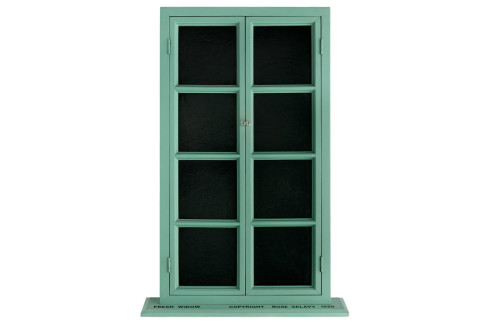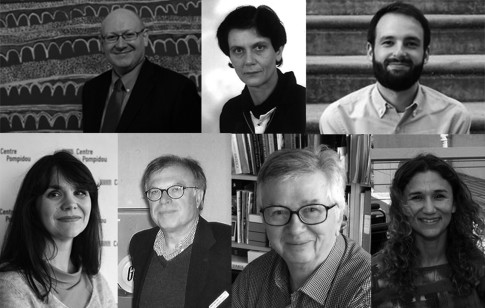
Abstract
Cécile Debray
Conservateur du Patrimoine, Curator Modern Collections of the MNAM / Centre Pompidou, Paris
Cécile Debray is intrigued by the paintings by Marcel Duchamp, the creator of one of the most hermetical works The Large Glass and its notes. Her talk will discuss the coherence of Duchamp’s research to reinvent and reformulate the concept of painting.
Marcel Duchamp’s paintings. Reception and display
The recent exhibition of Marcel Duchamp’s paintings at Centre Pompidou, La peinture, même (2014–2015) showed how these works, from 1910 to 1914, have been part of a complex esthetic research leading up to The Large Glass. The exhibition proposed a way to see and understand these paintings by Duchamp, how they have been received and considered through his posterity. It also introduced the question of how to display these eclectic and rare pieces of art in modern art collections at different museums, especially at the Centre Pompidou, Paris and the Museum of Modern Art, New York, USA compared to the Philadelphia Museum of Art, Philadelphia.
Paul B. Franklin
Independent scholar, Paris
Who knew that Marcel Duchamp executed a portrait during his visit to Stockholm in summer 1961? Paul B. Franklin will examine the history and importance of this little-known artwork.
Made in Stockholm: Portrait of Malou Höjer by Marcel Duchamp
On his first and only visit to Stockholm in summer 1961, Marcel Duchamp not only met Ulf Linde but also made the acquaintance of Linde’s friend, the French-born translator Malou Höjer. At the dinner party where Duchamp met Höjer, he drew her portrait. In his lecture, Paul B. Franklin will retrace the history of this little-known drawing, the only artwork that Duchamp created while in Stockholm and one that has never been included in any of three editions of the catalogue raisonné devoted to the artist’s work. Franklin will also contextualize this portrait in Duchamp’s oeuvre and document the many projects on which Linde and Höjer collaborated, including the first Swedish translation of Duchamp’s notes from the Green Box (1934). These groundbreaking endeavors not only rendered Duchamp’s work and ideas accessible to the Swedes but also helped disseminate Linde’s insightful and highly innovative understanding of Duchamp’s work beyond Sweden.
Adina Kamien-Kazhdan
David Rockefeller Curator of the Stella Fischbach Department of Modern Art, The Israel Museum, Jerusalem
What did originality, authenticity and authorship mean to Marcel Duchamp? The editioned ready-mades emerge as a device to spur rethinking, unhinge original meanings, and further blur conventional categories when it comes to discussing Duchamp’s major contribution to art.
Remaking the Readymade: Marcel Duchamp, Galleria Schwarz and the Conundrum of the Replica
Many of Marcel Duchamp’s original works were lost, dismantled, or destroyed. By the 1960s, only seven out of Duchamp’s fourteen original readymades remained extant. Duchamp recognized the power of replicas and multiples to convey novel concepts, amplify his reputation, and render his works iconic. This paper offers a new and detailed account of the commissioning and fabrication of the replicas and discusses the relationship between the replicas and the originals. Despite their lack of uniqueness, these signed and numbered editioned replicas, displayed in public and private collections from the 1960s onwards, gradually became mainstreamed and eventually became stand-ins for the lost originals, sharing in their status, aura, and value. This study contributes to a greater understanding of what originality, authenticity, and authorship meant for Duchamp, as the editioned readymades emerge as a device to spur rethinking, unhinge original meanings, and further blur conventional categories—aims which constitute Duchamp’s major contribution to art.
Alexander Kauffman
PhD Candidate, University of Pennsylvania, Philadelphia
How do Marcel Duchamp’s works after the Second World War relate to those he created ten, twenty, and thirty years prior? This talk examines the role of retrospection and historical self-consciousness in the creation of two new works following the artist’s wartime migration to New York.
The Bachelors Twenty Years Later: Marcel Duchamp, ca. 1945
In the span of a few months in the winter of 1945 and early spring of 1946, Marcel Duchamp completed one multi-year project, the short film Discs, and began another, Étant donnés: 1° la chute d’eau, 2° le gaz d’éclairage… The first revisits the artist’s previous film Anemic Cinema of 1925–26, and the second, his Large Glass of 1915–23. Documenting the production of the little-known Discs for the first time, this talk argues for its continuity with Étant donnés in a common elaboration upon forms of reproduction and adaptation first introduced in the Boite-en-Valise1935–41. Elided by postwar critical paradigms and Duchamp’s own later biographical accounts, these backwards-looking works nevertheless anticipated the reception of Duchamp’s art in the museum retrospectives, monographs, and secondary replications of the 1950s and 1960s.
Derek Pullen
Director, SculpConsLtd, London
According to Derek Pullen, former Head of Sculpture Conservation at Tate, the story of how Richard Hamilton’s reconstruction of the Large Glass was tragically damaged and eventually remade provides insights into Hamilton’s and Duchamp’s attitude to the artwork.
Whose work is it really? The conservation of The large Glass and Duchamp’s sculptures at Tate
In 1966 the British artist Richard Hamilton made a version of Duchamp’s The Bride Stripped Bare by Her Bachelors, Even, commonly referred to as The Large Glass. This talk is an account of how it came to be in the Tate collection and of its later misfortune, a mysterious event in 1984 that shattered one of the panels and was eerily reminiscent of what happened to Duchamp’s original artwork. The Tate’s Large Glass was conserved more than once, involving research that uncovered further information about both Hamilton’s and Duchamp’s attitude to their artwork. Until shortly before his death, Hamilton regarded his Large Glass as incomplete. The most recent conservation treatment resolved his concerns. The talk will describe the conservation of The Large Glass and discuss the questions raised about its status as an artwork and a replica. While Tate has yet to acknowledge what happened to The Large Glas, it has begun to develop a policy towards replicas. Once again, by seeding the Tate’s collection with at least 5 of his own replicas, Duchamp proved to be ahead of the game.
Gerhard Graulich
Head of the Painting Department and Deputy Director, Staatliches Museum Schwerin
Kornelia Röder
Curator, Staatliches Museum Schwerin
This talk will discuss the 90 works by Marcel Duchamp in the Staatliches Museum Schwerin and the impact these works have on the construction of art history.
How the Duchamp Collection changed Staatliches Museum Schwerin
After the Berlin Wall came down, all the museums in eastern Germany were faced with the question of how to reorient their activities to fit the context of European museums. By acquiring 90 works by Marcel Duchamp, Staatliches Museum Schwerin decided to follow in the international tradition of historical art collections. The immense inspiration Duchamp’s work has been for all manner of 20th century trends and the oeuvre’s ongoing topicality to this day laid the foundations for setting up a contemporary art collection. Artists such as Marcel Broodthaers, John Cage and Nam June Paik, works by the Fluxus movement and Mail Art have been integrated into the Collection and discussed in terms of how art historians have construed the relevant artworks referencing Duchamp.
With the establishment of the Duchamp Research Center in 2009 and given its interdisciplinary approach, a unique forum has been created at Schwerin Museum, one that allows research to be conducted directly in the Collection, which covers all phases of the artist’s oeuvre. The Center’s work has three main focuses: firstly, an research grant awarded annually and financed by the Friends of the Museum; secondly, a publication series by the name of Poiesis, bringing out works by renowned international experts on Duchamp; and thirdly, various exhibitions on all aspects of Duchamp’s oeuvre, in and outside Germany. Another publication series, Lecture Notes, has been founded specially for research by younger academics and available to anybody interested as downloads from the museum’s website.
Michael R. Taylor
Director, Hood Museum of Art, Dartmouth College, Hanover
According to André Breton, Marcel Duchamp was “the great hidden inspirer” of Surrealism in the 1940s. Dr. Taylor’s talk will explain how Duchamp’s non-confrontational attitude, absolute integrity, and openness to new forms of creative expression helped to revive the movement’s fortunes in its darkest hour.
The Great Hidden Inspirer”: Marcel Duchamp and Surrealism in Exile, 1942–1947
This paper will address the changing conditions of Surrealism during World War II, when the exiled group in the United States turned increasingly to an interior world of myth, magic, and Eros. I will argue that the catalyst for this shift in focus was Marcel Duchamp, whose fluent English, nonconformist attitude to life and art, and exceptional contacts in the American art world made him the best-qualified person to steer the group during this time of exile and crisis. André Breton had looked for guidance from Duchamp in this strange country, whose language he pointedly refused to learn. Duchamp thus arrived at a time when the Surrealist leader was at his most vulnerable, besieged by a series of crises, defections, and disappointments. Although never publicly stated, Breton effectively ceded leadership of the geopolitically displaced Surrealist group to Duchamp for the duration of the war and under his direction Surrealism was transformed into an inclusive, interdisciplinary, and less authoritarian and hierarchical movement. As Breton later acknowledged, Duchamp became “the great hidden inspirer” of Surrealism in the 1940s, when his non-confrontational attitude, absolute integrity, and openness to new forms of creative expression helped to revive the movement’s fortunes in its darkest hour.



